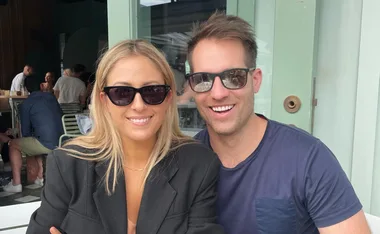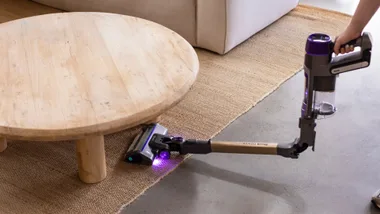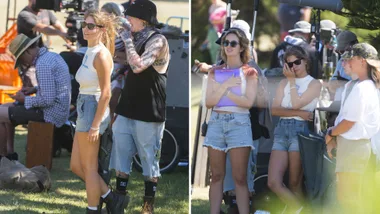Australia has had its fair share of gold rushes. Ballarat and Bendigo were built on them. And though you wouldn’t know it, we’re in the middle of another that’s going gangbusters, writes Mike Dolan.
We’ve come to Canberra to meet a dashing entrepreneur who’s as happy digging up dirt in search of gold as any miner. She’s whippet thin, elegant and today is sporting a red fluffy beret. Sherry McCardle-English is her name and she’s on her hands and knees in a paddock probing a patch of dirt the size of saucer with an immaculately manicured finger.
At her elbow is an American cocker spaniel, rigid with excitement, as her mistress unearths what looks like a Brazil nut.
“Black gold”, gasps one of the tour group, as Sherry holds it triumphantly between thumb and finger. The nugget is a truffle, one of the most prized ingredients of French cuisine — a fungus, with a notoriously difficult growing temperament, that thrives on the roots of oak and hazelnut trees.

A whopper weighing in at 1kg can fetch between $2500-$3000. Sherry’s record to date is 390 grams, worth about $900, which her sniffer dog, Snuffles, unearthed a few months back on her 142-hectare truffle plantation on the outskirts of Canberra.
If it sounds rather pie in the sky: Sherry and Snuffles digging up truffles on Ruffles estate, think again. It’s a serious business. In 2007, Australian truffle exports were valued at $1.6 million. Since then, they’ve grown 10 fold. And the sky is the limit. The French can’t get enough of them. And now the Australian public is catching on, too.
Truffle hunts are all the rage from WA to the ACT, in Tassie, NSW and SA, too, and at around $60 a pop, they’re worth their weight in gold. On one of Sherry’s French Black Truffles of Canberra hunts, punters learn how to enjoy a truffle’s aroma, savour its flavour with a truffled creme broulé and venture into a paddock with Snuffles, Shelly’s wonder dog.

Snuff and I are a team,” says Sherry, as the dog ferrets around the oak trees. Snuff’s sense of smell is 1000 times more sensitive than ours,” she adds. And as if on cue, the dog pats its paw on the ground — a sign that there’s a truffle underneath.
“I reckon Snuff’s got the easier job,” says a young girl on the tour group. And she’s got a point. To establish this plantation, Sherry has had to rigorously prepare the land. Around 80 tons of lime has been dug into every hectare, 2500 of saplings have been inoculated with truffle spores, before being planted, and a rabbit-proof fence has been erected around the property.
“The fence also keeps out the roos and vandals,” says Sherry. And it’s pretty high-tech, too. Touch it and spotlights flash on and an alarm, linked to the local police station, sounds.
Even so, without Snuffles, who Sherry has rigorously trained, “I wouldn’t have a clue where the truffles were,” admits Shelly. Traditional French truffle hunters use pigs to locate the fungi, says Shelly, but “I value my fingers and wouldn’t like to get between a pig and its truffle,” she says.
Truffles are a quintessentially French delicacy, but Australian truffles are now in demand in France. They only ripen in winter, so during the Northern summer, the French import their truffles from Down Under.
French-born chef Guillaume Brahimi uses only Australian truffles in his Melbourne, Sydney and Perth restaurants. He says their quality is outstanding. When Guillaume took Australian truffles to France, the local chefs were “blown away with their quality”.
In spite of recent successes, the Australian Truffle Growers Association warns that a truffle plantation is not a get-rich-quick scheme. There are more than 200 truffle growers Down Under in a great southerly strip stretching from WA, SA, Tasmania, NSW and the ACT, but it costs about $30,000 per hectare to start a truffle plantation and that’s no small change.
Although the truffle industry is growing at 25 per cent a year, cultivating truffles also requires great patience and skill.
Sherry McCardle-English has succeeded where many have failed. And even Sherry has had her failures. Her hazelnut trees have failed to produce any truffles.
“I never imagined that at the age of 62, I would be regularly running across a paddock swinging off the end of a dog lead!” she says, momentarily unbalanced by a yank at the lead as Snuffles discovers yet another nugget of black gold.

Just up the road at Canberra’s Fyshwick Markets, truffles are for sale and so is the expertise needed to cook with them. At Three Seeds Cooking School, Andrew Haskins runs several truffle classes during his Winter Cooking School.
At his Truffle Master Class ($155/$125), Andrew demonstrates how to cook Truffled Scrambled Eggs, Chicken Breast Filled With Truffle Brie and Ling Fillet with Mushroom, Cream and Truffle Sauce plus Truffle Butter, as his pupils follow suit at their own cooking stations. He has the rare knack of making slaving away in a kitchen great fun and his classes are informative and easy to follow. The best part, however, is that each pupil gets to eat what they’ve cooked.

TOP SPOTS TO EAT IN CANBERRA
When in season, the following restaurants serve up glorious meals using truffles:
Italian And Sons. Canberra’s most popular Italian trattoria in Braddon that serves food as good as you’ll find anywhere in Sydney or Melbourne. Recommended truffle dish: Tagliatelle With Tartufi, Portobello And Slippery Jack Mushrooms.
Elk And Pea. Serves excellent and imaginative Mexican food and the best breakfasts in Canberra.
An exhibition at the Canberra Glassworks – works by Jock Puautjimi and Luna Ryan. Photo by Mike Dolan.

A glass tile made at one of Canberra Glassworks’ workshops. Photo by Mike Dolan.




.png?resize=380%2C285)







